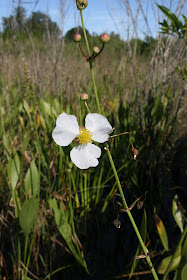 |
| Flower Close-up |
 |
| Foliage |
 |
| Ripening seed capsules |
Duck potato is a perennial forb that generally holds its basal leaves through the winter as long as temperatures are not too cold. It arises from a stout underground tuber, that is a food source for a few of the diving ducks. Over time, this plant spreads outward from these tubers and forms colonies. Stout lance-shaped leaves stand well above the waterline and can reach heights of 3 feet or more.
Flowering occurs during most months. The 4-5 foot tall stalks arise from the center of the basal leaves and multiple buds branch of this main stem. As in all members of this genus, the flowers are characterized by 3 broad white petals that surround a yellow center. They are pollinated by wetland butterflies, especially some of the grass skippers, and by bees. The flowers are followed by round seed capsules that are covered by small "warts." These eventually split into 3 sections and the seeds inside are dispersed.
This is a native species widely propagated by the native plant industry. Along with pickerelweed (Pontederia cordata), it is likely the most commonly planted wetland plant in Florida. As such, it makes an easy to grow addition to a lake edge planting or around an artificial pond. It will not thrive for long, however, if you can't keep it wet enough.

No comments:
Post a Comment
Please let me know if this site and the various postings have been useful to you.